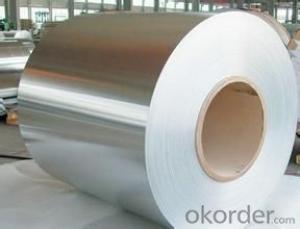Excellent Cold Rolled Steel Coil/Sheet -SPCCT-SB
- Loading Port:
- Tianjin
- Payment Terms:
- TT OR LC
- Min Order Qty:
- 30 m.t.
- Supply Capability:
- 5000000 m.t./month
OKorder Service Pledge
OKorder Financial Service
You Might Also Like
Specification
COLD ROLLED STEEL | |
Thicknenss | 0.10mm-4.00mm |
Width | 600mm-2000mm |
Sheets length | 1200-6000mm |
Coil inner diameter | 508-610mm |
Surface treatement | matt finish/bright finish,oiling/dry, bright anneal/black anneal |
Coil weight | 3-5t |
General Application of Cold Rolled Steel Coil:
1. Refrigerators, cabinets, power distribution baords and drums.
2. Automobile floor and roof panels.
3. Automobile fenders and quarter panels
4. Automobile fenders and quarter panels
Advantage
1. High Quality SurfaceFinish
2. High Dimensional Precision
3. Excellent mechanicalproperty
Package & Delivery
Package details: Standardseaworthy packing for international delivery.
Delivery: According to theexact quantity of your order.
Quality of the goods could be guaranteed. The finished product has a variety of excellent capabilities, such as continuous rolling, degreasing, annealing, skin pass, slitting and cut to length line etc. Along with it many rocessing capability and smooth, flat surface. It’s widely used in outdoor and interior decoration, furnishing.
- Q: Can you recycle steel? And if you wanted to buy some recycled steel, where would you get it?
- Steel is the most recycled material. But in recycling steel you would need the usual equipment in a foundry. The finished (recycled) product cannot be discerned visually. You cannot differ it from those coming from virgin steel ingots. The finished product (or steel material) would have to depend on your requirement, whether it is for structural, architectural or otherwise. For your requirement (enough to build a cruise ship), it would be best to go to a smelter. You might get better prices and quality compared to that from a scrap yard.
- Q: Which is more reactive? Zinc or Steel? And why?
- Zinc. Steel is an alloy consisting mostly out of iron, In the reactivity seris, zinc is more reactive than iron. Therefore, zinc is more reactive than steel
- Q: How are steel coils used in the manufacturing of automotive parts?
- Steel coils are used in the manufacturing of automotive parts as they are shaped and formed into various components such as body panels, chassis frames, and suspension parts. The coils are processed through a series of steps including cutting, bending, and stamping, to create the desired shape and size for each specific part. These steel components provide strength, durability, and structural integrity to the automobiles, ensuring their safety and performance on the road.
- Q: How many types of steel buildings are there?
- There are a number of designs which can be used to create different types of steel buildings as per the demands of the buyer or an investor. he various kinds of that can be constructed using steel are Homes, Hangars, Agriculture and Farm buildings for storage, Garages and Storage sheds, Open air sheds,, Barns, Arenas and stadiums, Automotive buildings with overhead doors and flexible framed openings, Religious buildings such as Churches and Temples, etc.
- Q: What are the common coil widths and thickness combinations available for steel coils?
- Common coil widths for steel coils range from 600mm to 2000mm, while common thickness combinations vary from 0.4mm to 3.0mm.
- Q: I have hundreds of pounds of scrap steel... who purchases this steel and what is the price per pound etc. of this? Does someone pick it up or do I bring it somewhere?
- It okorder /
- Q: How do steel coil manufacturers ensure fair pricing?
- Steel coil manufacturers ensure fair pricing by considering various factors such as production costs, market demand, and competition. They conduct cost analysis to determine the expenses involved in producing steel coils, including raw materials, energy, labor, and equipment. Manufacturers also evaluate market conditions and demand to set prices that align with prevailing rates. Additionally, they consider the pricing strategies of competitors to maintain a fair pricing structure that is competitive yet reflective of their costs and value proposition.
- Q: can you play one?
- i play acoustic, but i have tried to play a steel guitar before, my cousin has one. (:
- Q: Question about steel type used in bridges.?
- Do you mean galvanized steel?
- Q: How are steel coils used in the manufacturing of metal structures?
- Steel coils are used in the manufacturing of metal structures as they provide a convenient and efficient way to shape and form steel into various components. These coils are often processed through rolling mills to produce sheets or plates, which can then be cut, bent, or welded to create structural elements such as beams, columns, and trusses. The use of steel coils ensures uniformity, strength, and flexibility in the manufacturing process, allowing for the production of durable and reliable metal structures.
Send your message to us
Excellent Cold Rolled Steel Coil/Sheet -SPCCT-SB
- Loading Port:
- Tianjin
- Payment Terms:
- TT OR LC
- Min Order Qty:
- 30 m.t.
- Supply Capability:
- 5000000 m.t./month
OKorder Service Pledge
OKorder Financial Service
Similar products
Hot products
Hot Searches
Related keywords




























